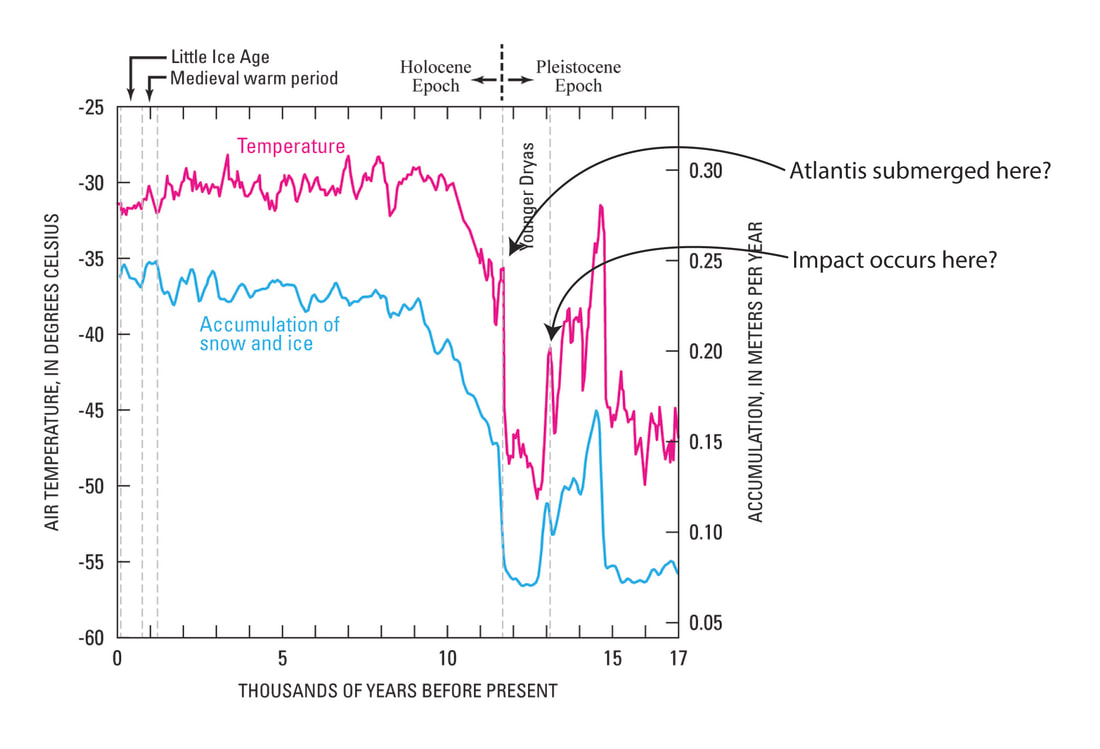On Friday we finished our section on Atlantis in this year's edition of Forbidden Archaeology. We spent most of the class watching and discussing a talk by Graham Hancock titled "Is the House of History Built on Foundations of Sand?" I wanted the students to watch carefully as Hancock made his case, asking them to think about his logic, the structure of the talk, and the evidence he presented to support his claims (many pieces of which they have already been exposed to).
I have not paid a whole lot of attention to Hancock in the past. I haven't completely read any of his books, and I think that this was the first time I have ever listened to an entire talk. He spent the first portion of the talk discussing the recent evidence for the hypothesis that an impact by a comet or meteor triggered the Younger Dryas. (The Younger Dryas is an anomalous cold period that occurred about 12,900-11,700 years ago during the transition from glacial to inter-glacial conditions.) He spent the last part of the talk highlighting some purported evidence (e.g., Gobekli Tepe, the Sphinx) supporting the claim that refugees from Atlantis occupied the Near East after fleeing their island's destruction.
The linkage that Hancock makes between the hypothesized extra-terrestrial impact that triggered the Younger Dryas and the destruction of Atlantis is, when you listen closely, peculiar. Following a quotation of Plato's description of Atlantis disappearing into the sea "in a single day and night of misfortune," Hancock describes the cataclysmic effects of extra-terrestrial impacts on the earth. He first discusses the idea that a comet wiped out the dinosaurs. He then moves on to the Younger Dryas impact research, repeatedly referring to "the cataclysm" of the impact.
So a comet or meteor wiped out at Atlantis?
No, the dates are all wrong for that. The Younger Dryas starts at about 12,900 BP (10,950 BC). Believers set the date of the destruction of Atlantis at 11,550 BP (9,600 BC). So, apparently, all the extra-terrestrial fireworks did nothing to the Atlanteans. They prospered for another 1300 years, conquering the world and mining orichalcum while the planet suffered a return to full glacial conditions.
After all the attention paid to violent cataclysm, Hancock actually attributes the destruction of Atlantis to sea level rise at the end of the Younger Dryas. Sea levels are lower during glacial periods because more of the Earth's water is tied up in ice sheets. Sea levels rise in inter-glacial periods because more of the Earth's water is in liquid form. As far as the culprit in Atlantis demise at 9,600 BC, Hancock points specifically to "a dramatic pulse of sea level rise" known as Meltwater Pulse 1b.
It will probably not surprise you to learn that, although there is debate about the magnitude, timing, and cause of Meltwater Pulse 1b, no scientist thinks it was so sudden or so rapid that it could have swallowed up a continent "in a single day and night of misfortune." Estimates of sea level rise range from about 6 to 28 meters, occurring over a period of several hundred to over a thousand calendar years. At least one study suggests the pulse didn't even start until hundreds of years after the purported submergence of Atlantis.






 RSS Feed
RSS Feed
